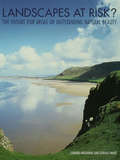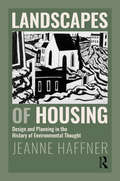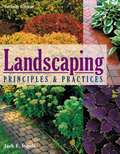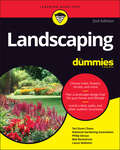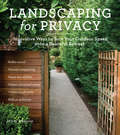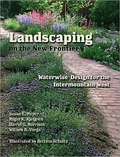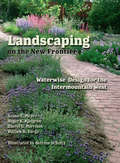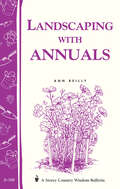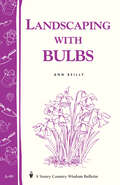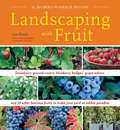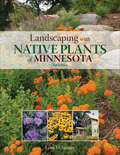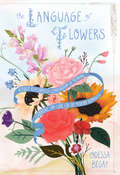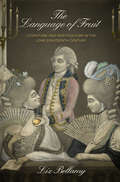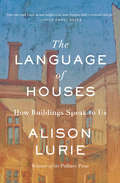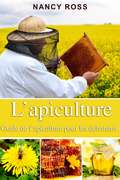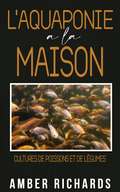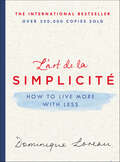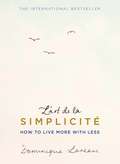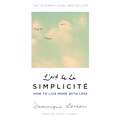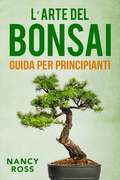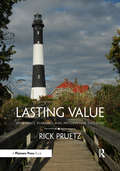- Table View
- List View
Landscapes at Risk?: The Future for Areas of Outstanding Natural Beauty in England and Wales
by Edward Holdaway Gerald SmartAreas of Outstanding Natural Beauty (AONBs) together with National Parks are the highest quality landscapes in England and Wales, and have been designated to conserve that quality. AONBs have always been regarded as 'second' to national parks in terms of the legislation and resources provided by the nation to look after them. At the turn of the century they are at a cross-roads - there are many challenges to be overcome if they are to survive as the best. This book examines whether they are fit to meet the challenges and sets out a bold new Agenda for their survival.Landscapes at Risk? covers the history and development of AONBs in England and Wales set in the context of protected landscapes generally in the UK. It focuses on the evolution of policies towards them, the arrangements for their administration, conservation and management, the land management and planning context within which they have evolved, and the adequacy of the proposals that have been put forward for their long-term well-being. Throughout the analysis there are numerous references to the many initiatives that have been and are being taken by AONB managers and others to secure their future. The book features a series of case studies of individual AONBs to illustrate the main points being made in the text.
Landscapes of Housing: Design and Planning in the History of Environmental Thought
by Jeanne HaffnerIn the twenty-first century, housing has become a site of ecological experimentation and environmental remediation. From the vantage point of contemporary architecture, conservation concerns and emergent building science technologies support one another, with new processes and materials deployed to reduce energy usage, water consumption, and carbon dioxide emissions. Landscapes of Housing examines this trend in historical perspective, arguing for a more considered environmental vision that includes the organic, social, and cultural dimensions of landscape. By shifting the focus from architecture, the book highlights and critiques the relationship between dwelling and landscape itself. Contributors from a wide range of international perspectives propose a more integrative ecology that includes history, culture, society, and materiality, in addition to technology, within contemporary ecological housing programs. This book will be a resource for upper-level students, academics, and researchers in landscape architecture interested in the social and political implications of ecological housing.
Landscaping: Principles and Practices (7th edition)
by Jack IngelsLandscaping: Principles & Practices, 7th Edition provides the basic knowledge and industry information needed to be successful in the field of landscape design and architecture. Focusing on three areas of professional practice; design, contracting and management, traditional topics such as design, plant installation, and pricing are covered, as well as topics not found in most other books, such as interior landscaping, xeriscaping, water gardens, and safety.
Landscaping Earth Ponds
by Tim MatsonThe guru of earth ponds explains how to site, design, shape, and plant these beloved fixtures of rural landscapes-and make them fit your property and your life. In the decades since he wrote his acclaimed "Earth Ponds," Tim Matson has designed scores of ponds, each unique to its site and its owners. In "Landscaping Earth Ponds," he shares what he has learned to make these captivating ponds truly fit into their landscapes and into the lives and lifestyles of their owners. Ponds have long been valued for their charm and utility: how else can you simultaneously enliven your landscape, create recreational opportunities, help the environment, and increase your property value? Earth ponds are increasingly recognized for the full range of gardening, landscaping, and ecological promise they hold. As pond-building methods have been perfected, more homeowners are restoring existing ponds or digging new ones. With dozens of color photographs, Matson shows you how to site a pond in right relation to your house, offering surprisingly simple ways to visually link the two. His proven methods and designs reflect the many moods water evokes. Screen your pond for privacy, create a sandy beach and natural diving platform, encourage wetland gardens, line the shores with moisture-loving perennials, or design your gardens and paths to create a sense of mystery and adventure.
Landscaping For Dummies
by Teri Dunn Chace National Gardening Association Philip Giroux Bob Beckstrom Lance WalheimCreate an eye-catching outdoor oasis with this no-nonsense guide to landscaping As families spend more time at home, they're expanding their living space to their yards, decks, and patios. When you're ready to upgrade the look of your landscape, Landscaping For Dummies offers advice on installing fences and walkways, choosing hardy plants and trees, and enhancing natural habitats for the critters and creatures lurking in your neighborhood. You'll find out how to make your backyard a relaxing retreat space and discover the enjoyment and satisfaction that comes from working in your yard. Landscaping For Dummies includes: Lists of recommended plants and varieties, including the best ones for privacy plantings, low-maintenance groundcovers, and small gardens Advice on how to deal with special landscaping concerns, including fire-prone areas, bee and butterfly gardens, and drought-tolerant and native landscapes Instructions on installing permanent features like decks, patios, fences, and more Pointers on how to water more efficiently, including the latest tools and technologies that can save you time With a little bit of planning and some digging, trimming, or planting, you'll be set to enjoy your yard whenever the mood strikes. Let Landscaping For Dummies be your guide to making the most of your outdoor space.
Landscaping for Privacy: Innovative Ways to Turn Your Outdoor Space into a Peaceful Retreat
by Marty WingateThe area around your home is your haven, your sanctuary, your refuge from the noise and irritation of traffic, eyesores, and nosy neighbors. Or at least it could be if there was some sort of barrier between your front yard and the sidewalk, or if you didn't have to stare at the back of the neighbors' garage when you want to relax on your patio. Landscaping for Privacy brims with creative ideas for minimizing or even eliminating the nuisances that intrude on your personal outdoor space. Scores of real-world examples show you how to keep the outside world at bay by strategically placing buffers (such as berms or groups of small trees), barriers (such as fences), and screens (arbors or hedges, for example) around your property. And the helpful plant lists tell you precisely which varieties to choose in order to enhance your sense of seclusion. If you've ever felt frustrated by the lack of privacy whenever you step outside your home, this inspiring book will steer you toward an achievable solution.
Landscaping on the New Frontier
by Susan E. Meyer Roger K. Kjelgren Darrel G. Morrison William A. VargaA practical volume for the home or business owner on landscaping with native, drought-tolerant plants in the Rocky Mountain West. Filled with color illustrations, photos, and design sketches, over 100 native species are described, while practical tips on landscape design, water-wise irrigation, and keeping down the weeds are provided. In this book you will learn how to use natural landscapes to inspire your own designed landscape around your business or home and yard. Included are design principles, practical ideas, and strong examples of what some homeowners have already done to convert traditional "bluegrass" landscapes into ones that are more expressive of theWest. Landscaping on the new Frontier also offers an approach to irrigation that minimizes the use of supplemental water yet ensures the survival of plants during unusually dry periods. You will learn how to combine ecological principles with design principles to create beautiful home landscapes that require only minimal resources to maintain.
Landscaping on the New Frontier: Waterwise Design for the Intermountain West
by Susan E. Meyer Roger K. Kjelgren Darrel G. Morrison William A. Varga Bettina SchultzA practical volume for the home or business owner on landscaping with native, drought-tolerant plants in the Rocky Mountain West. Filled with color illustrations, photos, and design sketches, over 100 native species are described, while practical tips on landscape design, water-wise irrigation, and keeping down the weeds are provided. In this book you will learn how to use natural landscapes to inspire your own designed landscape around your business or home and yard. Included are design principles, practical ideas, and strong examples of what some homeowners have already done to convert traditional "bluegrass" landscapes into ones that are more expressive of theWest. Landscaping on the new Frontier also offers an approach to irrigation that minimizes the use of supplemental water yet ensures the survival of plants during unusually dry periods. You will learn how to combine ecological principles with design principles to create beautiful home landscapes that require only minimal resources to maintain.
Landscaping Principles And Practices (6th Edition)
by Jack E. IngelsNewly reorganized and updated, the fifth edition of this popular text offers a comprehensive introduction to landscape management. To present a balanced view of the industry as a process, the text is now organized by the industry's three career areas - design, contracting, and maintenance - to illustrate the interdependence of these areas. New material covers such current topics as xeriscaping and landscape calculations, providing students with the latest in landscaping techniques and management. Excellent for launching students into landscaping careers!
Landscaping Principles & Practices
by Jack E. IngelsLandscaping: Principles & Pratices, 7th Edition provides the basic knowledge and industry information needed to be successful in the field of landscape design and architecture. Focusing on three areas of professional practice; design, contracting and management, traditional topics such as design, plant installation, and pricing are covered, as well as topics not found in most other books, such as interior landscaping, xeriscaping, water gardens, and safety.
Landscaping with Annuals: Storey's Country Wisdom Bulletin A-108
by Ann ReillySince 1973, Storey's Country Wisdom Bulletins have offered practical, hands-on instructions designed to help readers master dozens of country living skills quickly and easily. There are now more than 170 titles in this series, and their remarkable popularity reflects the common desire of country and city dwellers alike to cultivate personal independence in everyday life.
Landscaping with Bulbs: Storey's Country Wisdom Bulletin A-99 (Storey Country Wisdom Bulletin Ser.)
by Ann ReillySince the 1973 publication of Storey's first Country Wisdom Bulletin, our commitment to preserving the arts, crafts, and skills of country life has never wavered. We now have more than 200 titles in this series of 32-page publications, and their remarkable popularity reflects the common desire of country and city dwellers alike to cultivate personal independence in everyday life.
Landscaping with Fruit: Strawberry ground covers, blueberry hedges, grape arbors, and 39 other luscious fruits to make your yard an edible paradise.
by Lee A. ReichDiscover the joy of homegrown apples, fresh-picked cherries, and dozens of other fruits with this definitive guide to creating a more delicious backyard! Lee Reich shows you how to grow temperate-zone fruit at home, from site analysis and climate assessment through plant selection, pest control, pruning, and harvesting. A plant-by-plant guide recommends 39 palate-pleasing species that are especially well-suited to the home landscape. Add beauty to your outdoor space while bringing organic fruit to your table. This publication conforms to the EPUB Accessibility specification at WCAG 2.0 Level AA.
Landscaping with Native Plants of Minnesota
by Lynn M. SteinerAn updated guide to Minnesota’s hardy native plants and how to incorporate them into your home landscape—with profiles of flowers, trees, shrubs, and more.Gardeners enjoy Minnesota’s native plants for more than their beauty. They are low maintenance, can survive difficult soil and weather conditions, provide unique landscape options, and celebrate the state’s natural heritage. In this second photo-filled edition of Landscaping with Native Plants of Minnesota, you’ll learn how to identify native plants, keep them healthy and thriving in the state’s harsh climate, and design and install an attractive home landscape perfect for your lifestyle. Also included in this new edition are comprehensive plant profiles and gardening essentials for approximately 350 native flowers, trees, shrubs, vines, evergreens, grasses, and ferns that grew in Minnesota before European settlement, as well as complete information on planting, maintenance, and landscape uses for each plant.
The Language of Flowers: A Fully Illustrated Compendium of Meaning, Literature, and Lore for the Modern Romantic
by Odessa BegayWith gorgeous full-color illustrations, ornate decorative elements, lettering in metallic ink, and engaging text, The Language of Flowers: A Fully Illustrated Compendium of Meaning, Literature, and Lore for the Modern Romantic is a treasure for flower lovers. A sumptuous, contemporary anthology of 50 of the world's most storied and popular flowers, each of its entries offers insight to the meaning associated with the flower, and is a fascinating mix of foklore, classic mythology, literature, botanical information and popular culture. Following an introduction that provides a short history of the language of flowers, a fad which reached its peak during the reign of Queen Victoria, each uniquely illustrated and designed entry is an enjoyable read full of history and little-known facts. Here is the story of Tulipmania; how the pansy got its "face," and why the most particular pollination process of a certain orchid has made the vanilla bean a very dear commodity. You'll also dicover how Christian Dior's passion for lily of the valley inspired his classic perfume Diorissimo and its extraordinary bottle; why Oscar Wilde had a penchant for wearing green carnations in his lapel; and how Greeks and Romans believed snapdragons could ward off witchcraft, so they planted them at entryways to their homes. With more than a dozen two-page paintings evoking the romance of noteworthy Victorian gardens and symbolic bouquets, a cross-referenced index of flowers and meanings, and suggestions for further reading, this book is a must for lovers of floriology and Victoriana.
The Language of Fruit: Literature and Horticulture in the Long Eighteenth Century (Penn Studies in Landscape Architecture)
by Liz BellamyIn The Language of Fruit, Liz Bellamy explores how poets, playwrights, and novelists from the Restoration to the Romantic era represented fruit and fruit trees in a period that saw significant changes in cultivation techniques, the expansion of the range of available fruit varieties, and the transformation of the mechanisms for their exchange and distribution. Although her principal concern is with the representation of fruit within literary texts and genres, she nevertheless grounds her analysis in the consideration of what actually happened in the gardens and orchards of the past.As Bellamy progresses through sections devoted to specific literary genres, three central "characters" come to the fore: the apple, long a symbol of natural abundance, simplicity, and English integrity; the orange, associated with trade and exchange until its "naturalization" as a British resident; and the pineapple, often figured as a cossetted and exotic child of indulgence epitomizing extravagant luxury. She demonstrates how the portrayal of fruits within literary texts was complicated by symbolic associations derived from biblical and classical traditions, often identifying fruit with female temptation and sexual desire. Looking at seventeenth-century poetry, Restoration drama, eighteenth-century georgic, and the Romantic novel, as well as practical writings on fruit production and husbandry, Bellamy shows the ways in which the meanings and inflections that accumulated around different kinds of fruit related to contemporary concepts of gender, class, and race.Examining the intersection of literary tradition and horticultural innovation, The Language of Fruit traces how writers from Andrew Marvell to Jane Austen responded to the challenges posed by the evolving social, economic, and symbolic functions of fruit over the long eighteenth century.
The Language of Houses: How Buildings Speak to Us
by Alison LurieHow do the spaces we inhabit affect us—and reflect us? A Pulitzer Prize–winning author explores architecture, in this insightful, &“breezy&” read (The Washington Post). In 1981, Alison Lurie published The Language of Clothes, a meditation on costume and fashion as an expression of history, social status and individual psychology. Amusing, enlightening and full of literary allusion, the book was highly praised and widely anthologized. Now Lurie has returned with a companion book, The Language of Houses, a lucid, provocative and entertaining look at how the architecture of buildings and the spaces within them both reflect and affect the people who inhabit them. Schools, churches, government buildings, museums, prisons, hospitals, restaurants, and of course, houses and apartments—all of them speak to human experience in vital and varied ways.The Language of Houses discusses historical and regional styles and the use of materials such as stone and wood and concrete, as well as contemplating the roles of stairs and mirrors, windows and doors, tiny rooms and cathedral-like expanses, illustrating its conclusions with illuminating literary references and the comments of experts in the field. Accompanied by lighthearted original drawings, The Language of Houses is an essential and highly entertaining new contribution to the literature of modern architecture.
L’apiculture: Guide de l’apiculture pour les débutants
by Nancy RossDÉCOUVREZ UN MOYEN FACILE DE SE METTRE À L’APICULTURE ! Que vous vouliez produire votre propre miel, stimuler la production de votre jardin potager ou savourer le pur plaisir de l’apiculture, ce livre peut vous aider. Voici un aperçu de ce que vous allez apprendre... Combien de ruches devrais-je avoir ? Où est-ce que je trouve mes abeilles ? Choisir les bonnes fournitures Installer votre ruche Comment récolter le miel Problèmes courants que vous pouvez rencontrer avec l’apiculture Conseils pour réussir dans l’apiculture Et bien plus !
L'aquaponie à la maison : Cultures de poissons et de légumes
by Amber RichardsVous êtes-vous déjà demandé ce qu'était l'aquaponie ? Est-elle viable pour votre situation ? Ce livre électronique est un bon aperçu pour vous aider à répondre à ces questions et plus encore. L'aquaponique est la science révolutionnaire qui permet de faire pousser des plantes dans l'eau au lieu de la terre. Cette eau permet également l'élevage de poissons. Les déchets produits par la Les poissons d'élevage ou autres créatures aquatiques fournissent les nutriments nécessaires aux plantes, et purifie l'eau à son tour. Lorsqu'elle est correctement installée, l'aquaponie peut être autonome et constituer un pour les poissons et les plantes. Aquaponics At Home est un guide pour les débutants dans ce domaine. On vous donne le fondamentaux de cette merveilleuse et passionnante façon de jardiner, y compris les composants dont vous avez besoin, et les moyens de mettre en place votre propre système aquaponique sain qui fournit des aliments sûrs, frais et délicieux tout au long de l'année. Téléchargez votre copie maintenant.
L'art de la Simplicité: How to Live More with Less
by Dominique LoreauDiscover the magic of simplicity in this international bestseller, available for the first time in English.Dominque Loreau is the master in the art of de-cluttering and simplifying. Now her groundbreaking L’art de la Simplicité, a huge bestseller in her native France, is translated into English for the first time. Loreau’s principle of “less is more” is set to change your life forever.Living in Japan and inspired by Asian philosophy, Loreau takes you on a step-by-step journey to a clutter-free home, a calm mind and an energized body. Free yourself of possessions you don’t want or need; have more money to spend on life’s little luxuries; eat better and lose weight; and say goodbye to anxiety and negative relationships.Give yourself the gift of health and happiness; to live fully and freely is to live with L’art de la Simplicité.
L'art de la Simplicité (The English Edition): How to Live More With Less
by Dominique LoreauIf simplicity is an art, then Dominique Loreau is a master. Having lived in Japan for many years and inspired by oriental philosophy, Dominique Loreau discovered the beauty of a life well lived through the art of simplicity. Her lifestyle rests on the principle of 'less is more', and imbues all areas of existence, from the material to the spiritual. She captured her philosophy in the ground-breaking L'art de la Simplicité, which was an massive bestseller in her native France and is now available in the English language for the first time. Simplify your home, empty your wardrobe, abandon compulsive purchases, eat more frugally but better, take care of your body and mind. From the art of feeling well in your home to the art of feeling well in your body, this compelling and elegant book will transform your life and take you on an empowering journey to happiness. You will feel energised, more confident and free. You will discover the essence of being truly alive and how to live a more centred life. One full of real pleasure, clarity and satisfaction.
L'art de la Simplicité (The English Edition): How to Live More With Less
by Dominique LoreauIf simplicity is an art, then Dominique Loreau is a master. Having lived in Japan for many years and inspired by oriental philosophy, Dominique Loreau discovered the beauty of a life well lived through the art of simplicity. Her lifestyle rests on the principle of 'less is more', and imbues all areas of existence, from the material to the spiritual. She captured her philosophy in the ground-breaking L'art de la Simplicité, which was an massive bestseller in her native France and is now available in the English language for the first time. Simplify your home, empty your wardrobe, abandon compulsive purchases, eat more frugally but better, take care of your body and mind. From the art of feeling well in your home to the art of feeling well in your body, this compelling and elegant book will transform your life and take you on an empowering journey to happiness. You will feel energised, more confident and free. You will discover the essence of being truly alive and how to live a more centred life. One full of real pleasure, clarity and satisfaction.(p) 2016 Orion Publishing Group
L’arte del bonsai: guida per principianti
by Nancy Ross Barbara ParuttoVolete Apprendere I Concetti Di Base Per la Coltivazione Dei Bonsai? Ecco cosa imparerete con questo libro: Scegliere l’ambiente giusto per il bonsai Fornire al bonsai le sostanze nutritive di cui necessita Potare il bonsai Gli strumenti più utili per prendersi cura del bonsai Rinvasare il bonsai E molto altro ancora!
Lasting Value: Open Space Planning and Preservation Successes
by Rick PruetzAmericans are committing 'country-cide', says Rick Pruetz, FAICP, converting farms into suburban yards and channeling streams that once provided flood control, water purification, habitats, and recreational opportunities. But rather than rail against overdevelopment, this book celebrates communities succeeding in preservation. For ten years Pruetz explored communities that excel in saving their natural environment. In twenty-four illustrated vignettes, he captures the character of places from the volcanic range near downtown Albuquerque, New Mexico, to Minneapolis’s Grand Rounds park system, to farmland improbably preserved on Long Island. As the longtime city planner of Burbank, California, Pruetz offers more than an appreciation of these communities. He brings a planner’s-eye view of the practices behind their achievements. His detailed reports of creative preservation solutions mark the trail for planners, commissioners, and citizens who seek to preserve the green legacy in their own backyards.
Latin America: Writings on Architecture, Landscape, and the Environment, 1876-1925
by Jacques LambertThis title is part of UC Press's Voices Revived program, which commemorates University of California Press’s mission to seek out and cultivate the brightest minds and give them voice, reach, and impact. Drawing on a backlist dating to 1893, Voices Revived makes high-quality, peer-reviewed scholarship accessible once again using print-on-demand technology. This title was originally published in 1967.
